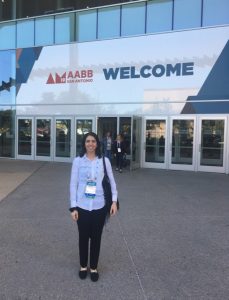 By Dr. Narges Hadjesfandiari, Postdoctoral Fellow, Devine Lab
By Dr. Narges Hadjesfandiari, Postdoctoral Fellow, Devine Lab

Narges at the AABB 2019 conference.
AABB, previously known as the American Association of Blood Banks, has held an annual meeting since 1947 to address advances and standards in the field of transfusion medicine. Over the years, AABB has expanded to much more than its name in both its scope of fields of interest as well as its member diversity, so it has only been known by its acronym since 2005. Thanks to the CBR Travel Award and support by Dr. Devine’s lab, I attended the AABB 2019 meeting in San Antonio, Texas, from Oct. 18 to 22 in 2019.
I really enjoyed the combination of specialized talks related to my work as well as general sessions. Among the general sessions, “MythBusters” and “Controversial Uses of Blood Components” were highlights for me. In “MythBusters”, Dr. Mary Townsend, a senior medical director at Vitalant, demonstrated that the “deferral of donors with certain pre-cancerous or cancerous conditions from blood donation” is a myth, and that this donor population should be recruited. However, in the end she left everyone to reflect by asking how we would feel about our loved ones receiving blood from a cancer patient.
Later, Dr. Kevin Land, also from Vitalant, revealed that a once-considered myth about transient allergies is actually true. Yes! You can get a transient peanut allergy after receiving blood from a person with this allergy. Furthermore, a child with a known peanut allergy once actually had an allergic reaction following a blood transfusion from a donor who ate handfuls of peanuts the day before. He reminded us to think of blood as more than just cells and plasma.
The “Oxygen Paradox” session was particularly relevant to my research. I use oxidative hemolysis as a marker to evaluate red cell samples from different donors. Some donor characteristics affecting red cell oxidative damage were discussed, plus interesting recent advances and research that encouraged the storage of red cells under hypoxic conditions.
I presented two projects from Dr. Devine’s lab that I worked on with Drs. Levin and Serrano at the conference. My talk was about the importance of the prompt production of red cells when using the whole blood filtration method, in order to have higher quality products during storage. I received interesting questions from the audience and some thoughts to work on. I also won a trainee award for this talk, which made my first AABB meeting special. Our poster addressed a daily challenge of cryoprecipitate inventory in Canada. Although Canadian Society for Transfusion Medicine Standards states that “adult recipients can be transfused with any ABO group of cryoprecipitate”, hospital orders for AB-Cryos are disproportionately high and sometimes cannot be met by blood banks. By measuring Anti-A/B activity in cryoprecipitate samples and making a risk model, we provided further evidence supporting this standard. We hope that our work will debunk some myths!
Last but not least, I have to mention another highlight of the conference: San Antonio! San Antonio is famous for its River Walk and the Alamo, an historic battle site. There were restaurants and loud music on both sides of the river and many tourists took a ride on horse-drawn carriages that were beautifully decorated. The temperature was almost always above 25°C during our stay, which made this city a perfect conference place for me, a person who always feels cold!


